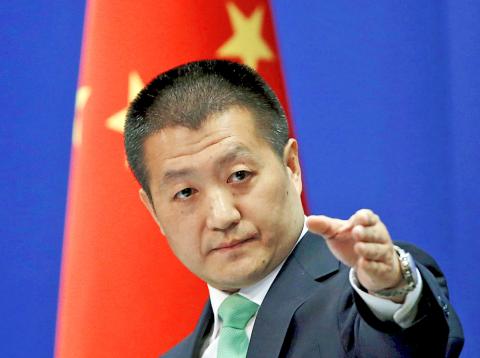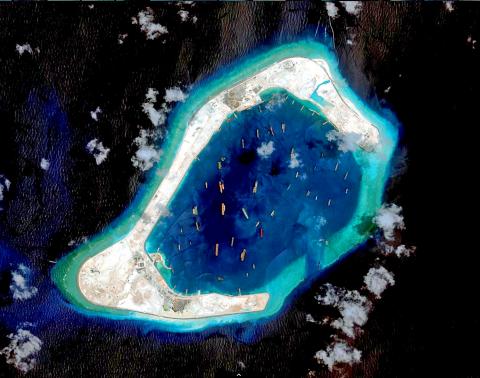The US yesterday defied China by sending a warship close to artificial islands China is building in disputed waters, prompting Beijing to furiously denounce what it called a threat to its sovereignty.
The USS Lassen passed within 12 nautical miles (22.2km) — the normal limit of territorial waters around natural land — of at least one of the formations Beijing claims in the South China Sea.
Chinese authorities “monitored, shadowed and warned” the guided-missile destroyer in the Spratly islands (Nansha Islands, 南沙群島) — which Taiwan, Malaysia, the Philippines, Vietnam and Brunei also state claims to — Beijing said.

Photo: EPA
Washington’s long-awaited move to assert freedom of navigation might escalate the dispute over the strategically vital waters, where Beijing has been transforming reefs and outcrops into artificial islands with potential military use.
China claims sovereignty over almost the whole of the area, raising concerns it could one day seek to dictate who might transit its bustling sea lanes.
The dispute has raised fears of clashes in an area through which one-third of the world’s oil passes.

Photo: Reuters
The US action was part of the nation’s “routine operations in the South China Sea in accordance with international law,” a US official said.
“We will fly, sail and operate anywhere in the world that international law allows,” he added.
Chinese Ministry of Foreign Affairs spokesman Lu Kang (陸慷) blasted the exercise, saying the ship had “illegally entered” the waters near the islands “without receiving permission from the Chinese government.”

Photo: CNA
Beijing “resolutely opposes any country using freedom of navigation and overflight as a pretext for harming China’s national sovereignty and security interests,” he said, adding: “[China will] staunchly defend its territorial sovereignty.”
China’s Xinhua news agency condemned a “flagrant and baseless provocation” that added to regional instability.
However, despite the Chinese rhetoric, analysts said more such operations could be expected.
Beijing’s so far limited response showed that it had had “its bluff called,” said Rory Medcalf, director of the International Security Program at the Lowy Institute in Sydney.
“The US, and its allies and partners, should now help the Chinese leadership in saving face, by emphasizing that freedom of navigation operations are normal, not extraordinary,” he said.
There have been repeated confrontations in the area between Chinese vessels and boats from some of its neighbors who assert rights to the waters, particularly the Philippines and Vietnam.
Both are members of ASEAN, which has long called on China to negotiate a code of conduct in the region, as are fellow claimants Brunei and Malaysia. Taiwan also states claims over part of the sea.
Manila has infuriated the world’s second-largest economy by taking the dispute to a UN tribunal, and Philippine President Benigno Aquino III said the US action demonstrated that “the balance of power says that there is not just a single voice that must be adhered to.”
Beijing’s South China Sea reclamations have been seen as an attempt to assert its claims by establishing physical facts in the water, but Aquino said: “There is no de facto changing of the reality on the ground.”
Beijing has repeatedly said the construction work is primarily for civilian purposes, and Chinese President Xi Jinping (習近平), during a visit to Washington last month, pledged that the nation would not militarize the area.
However, satellite images of the islands published by the Washington-based Center for Strategic and International Studies (CSIS) show that Beijing has reclaimed millions of square meters of land in the Spratlys.
The pictures also show a host of facilities with the potential for military applications being developed, including as many as three runways, at least one of them 3,000m long.
The US, which is engaged in a foreign policy “pivot” to Asia, and China, which has the world’s largest military and is expanding the reach of its navy, are jockeying for position in the Pacific region.
Beijing regularly calls for a “new model of major country relations,” implying equality between the world’s top two economic and military powers.
The US’ operations yesterday were “not directed at any specific country,” the US official said.
“US forces operate in the Asia-Pacific region on a daily basis, including in the South China Sea,” he added.
The sail-by was “long overdue,” said Bonnie Glaser, a senior China expert at CSIS, adding that the exercises “should be done quietly, regularly and often.”
“There should be no media fanfare,” she said.
“The way this has been handled has left the Chinese believing that the US is challenging its sovereignty, rather than simply exercising freedom of the seas,” she added.
Later yesterday, Chinese Vice Minister of Foreign Affairs Zhang Yesui (張業遂) summoned US ambassador to China Max Baucus. Zhang called the US patrol “extremely irresponsible” and urged the US to cease actions that harm China’s sovereignty and security interests, China Central Television reported.

US President Donald Trump yesterday announced sweeping "reciprocal tariffs" on US trading partners, including a 32 percent tax on goods from Taiwan that is set to take effect on Wednesday. At a Rose Garden event, Trump declared a 10 percent baseline tax on imports from all countries, with the White House saying it would take effect on Saturday. Countries with larger trade surpluses with the US would face higher duties beginning on Wednesday, including Taiwan (32 percent), China (34 percent), Japan (24 percent), South Korea (25 percent), Vietnam (46 percent) and Thailand (36 percent). Canada and Mexico, the two largest US trading

AIR SUPPORT: The Ministry of National Defense thanked the US for the delivery, adding that it was an indicator of the White House’s commitment to the Taiwan Relations Act Deputy Minister of National Defense Po Horng-huei (柏鴻輝) and Representative to the US Alexander Yui on Friday attended a delivery ceremony for the first of Taiwan’s long-awaited 66 F-16C/D Block 70 jets at a Lockheed Martin Corp factory in Greenville, South Carolina. “We are so proud to be the global home of the F-16 and to support Taiwan’s air defense capabilities,” US Representative William Timmons wrote on X, alongside a photograph of Taiwanese and US officials at the event. The F-16C/D Block 70 jets Taiwan ordered have the same capabilities as aircraft that had been upgraded to F-16Vs. The batch of Lockheed Martin

China's military today said it began joint army, navy and rocket force exercises around Taiwan to "serve as a stern warning and powerful deterrent against Taiwanese independence," calling President William Lai (賴清德) a "parasite." The exercises come after Lai called Beijing a "foreign hostile force" last month. More than 10 Chinese military ships approached close to Taiwan's 24 nautical mile (44.4km) contiguous zone this morning and Taiwan sent its own warships to respond, two senior Taiwanese officials said. Taiwan has not yet detected any live fire by the Chinese military so far, one of the officials said. The drills took place after US Secretary

THUGGISH BEHAVIOR: Encouraging people to report independence supporters is another intimidation tactic that threatens cross-strait peace, the state department said China setting up an online system for reporting “Taiwanese independence” advocates is an “irresponsible and reprehensible” act, a US government spokesperson said on Friday. “China’s call for private individuals to report on alleged ‘persecution or suppression’ by supposed ‘Taiwan independence henchmen and accomplices’ is irresponsible and reprehensible,” an unnamed US Department of State spokesperson told the Central News Agency in an e-mail. The move is part of Beijing’s “intimidation campaign” against Taiwan and its supporters, and is “threatening free speech around the world, destabilizing the Indo-Pacific region, and deliberately eroding the cross-strait status quo,” the spokesperson said. The Chinese Communist Party’s “threats